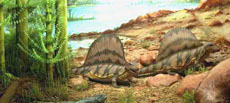 |
 |
 |
 |
 |
Produced
by the Population Genetics and Evolution class, Furman University |
||||
 |
 |
 |
 |
 |
Produced
by the Population Genetics and Evolution class, Furman University |
||||
 |
Pangaea
and the Permian Climate |
 |
||
| Alfred Wegener,
the first advocate of the theory of continental drift, first proposed
the existence of a single 'supercontinent' to explain geographical, geological,
and paleontological patterns (Kazlev 1998). However, it wasn’t until
the 1960’s that modern technologies like sonar, radar, and the study
of paleomagnetism were used to test and confirm his hypothesis. The most
recent supercontinent to form was Pangaea, which formed in the Permian
when Gondwanaland (a southern continent) and Laurasia (the northern continent)
met. The rest of the Earth was a part of the giant Panthalassa Ocean (Speer
2002). With only one large land mass, the majority of land was inland
- away from the cool, moist ocean air (Goodwin 2001). The extensive inland
areas were probably dry continental climates. This may have been the environmental
trigger that gave a selective advantage to seed plants and reptiles that
would dominate during the coming Mesozoic (Kazlev 1998). The lack of coastline
was also decremental to the marine organisms due to a loss of habitat
(Goodwin 2001).
Page by Megan Aprill |
 |
| Representation of Pangaea from: Old Wood History | |
|
Goodwin A. 2001. Formation of Pangaea. Palaeobiology and Biodiversity Research Group. March 17, 2010. Kazlev MA. 1998. Pangea: The Global Supercontinent- Permian to Early Jurassic. www.palaeos.com . Accessed March 17, 2010. Speer BR. 2002. The Permian. University of California Museum of Paleontology (UCMP). Accessed March 17, 2010. |